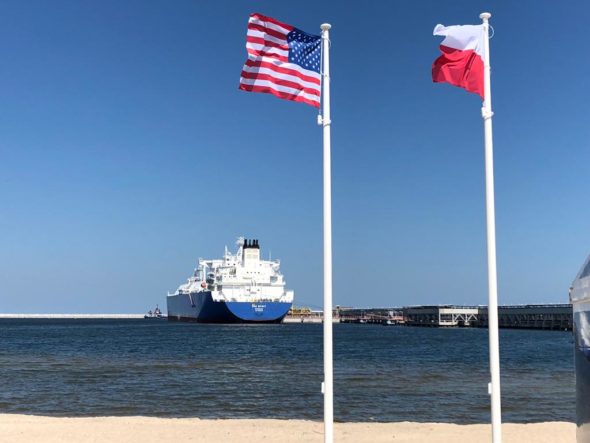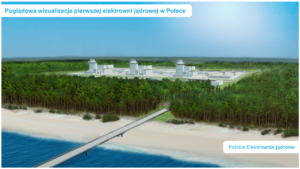Russia will stop supplying gas to Poland at 8 am Polish time on April 27, when the new contract period will start. This is another instance of blackmail, this time with the use of the ruble ultimatum, which proves that the plans to abandon Russian gas have had merit. This may be the beginning of a new phase of Gazprom’s ploy in Europe, which will become the biggest challenge in the coming fall, writes Wojciech Jakóbik, editor-in-chief at BiznesAlert.pl.
Russians have been reducing the supply of gas to Europe since the summer of 2021 and thus fuelling the energy crisis thanks to the convergence of prices for this fuel with the cost of electricity on the European stock exchanges. So, it’s not that Russia changed its behavior, rather it started a new phase with the ruble ultimatum at the center. President Vladimir Putin has threatened to stop gas supplies in April if EU countries did not change the currency of payment from euros or dollars to rubles. However, it was a peculiar kind of April Fool’s joke, because the Kremlin spokesman Dmitry Peskov had to quickly inform Putin that it was impossible to make such a change overnight.
Poland is safe for now
However, the change ordered in a special presidential decree involves a more compromise solution, that is, Gazprombank converting the payments made by Europeans to rubles with the help of the Moscow exchange. The European Commission allowed such a possibility, provided that the Russians agreed to it, but stipulated that the member states could determine that the usual transfer of funds in the previously agreed on currencies meets contractual obligations. This was probably the case for Poland and Bulgaria, which were informed by Gazprom that gas supplies to their territory would be stopped as of 27 April. The import from Russia to Poland began to decline on April 25, when there occurred the first interruptions in deliveries through the Yamal pipeline, which runs through Russia and Belarus and then across Poland. The Yamal remained empty, although by 8 am on 27 April deliveries had risen again to 4 million kWh, according to ENTSO-G Data.
No new data were released before this text was published. According to ENTSO-G, deliveries to Poland via Ukraine at the Wysokoje point went down from about 6 registered in March, 4 in April, to 3 million kWh registered as of April 26. The Government Plenipotentiary for Strategic Energy Infrastructure Piotr Naimski revealed at a press conference that as per the Yamal agreement the contract period ends in Poland at 8 am. Therefore, it is to be expected that the Russian declaration will enter into force after this hour, and then the supply stream through Ukraine will also dry up.
Fall will be hot
In the coming weeks Poland will remain safe and it won’t have to use any of its gas reserves. Currently, the country’s gas storage facilities are full at 76 percent of their 3 bcm capacity. They have been replenished since 25 February when Russia attacked Ukraine. This amount of gas is enough to cover the demand for about two months without any import. However, Poland does have the ability to get gas outside of Russia. The country has been working towards this goal for many years now. Domestic production is expected to reach 3.8 billion cubic meters in 2022. The LNG terminal in Świnoujście can import up to 6.3 bcm of gas a year, but its full potential has not been used yet. As of the first of May, 2 billion cubic meters annually will be made available via the Poland-Lithuania gas pipeline. According to my scoop, PGNiG has contracted 5-6 tankers from the Lithuanian FSRU until October 2022, when the Baltic pipeline from Norway, with an initial capacity of up to 3 billion cubic meters a year, will be ready. The pipe’s target capacity is 10 bcm a year. Out of that about 2.5 bcm a year will come from deposits controlled by PGNiG, which is the cheapest option. The rest will be bought on the basis of long-term and spot contracts. Gas demand in Poland is 20 bcm, and the sum of these sources gives 15-25 bcm. This non-Russian gas can be supplemented via the reverse flow on the Yamal gas pipeline with a capacity of 5.5 billion cubic meters annually, through the Poland-Slovakia pipeline with a capacity of 6 billion cubic meters annually since May, and the Poland-Czech Republic pipeline with a capacity of 0.5 billion cubic meters. However, this gas will come from the stock exchange, and to a large degree will be purchased via spot contracts, which other countries will also pursue. This means their availability will depend on Gazprom, which in 2021 covered 41 percent of gas deliveries to Europe, which means it supplies these markets to a large degree. This will be important in the fall, when the heating season begins, and Europeans will compete for gas. Russia will try to use this opportunity to drive a wedge between EU members.
Is Gazprom playing a tactical or strategic game?
If Gazprom’s game, with the ruble ultimatum at its center, is a temporary measure designed to divide European customers into those who will get gas for rubles and those who will be cut off for defending contractual provisions, there will be nothing left but to argue in court. One can then imagine a scenario in which supplies from the Yamal will return to normal, provided that there is no EU embargo on Russian gas. The Poles have already won the dispute over the Yamal contract before an arbitration court in 2020, and are capable of doing it again, because Gazprom may have violated the contract. However, if the actions of the Russians are a prelude to the next phase of the European gas crisis, for example in order to divert attention from the attack on Moldova or other actions in Ukraine, crisis plans drafted in case Russia stops gas supply must be implemented. Such plans were prepared earlier. It was no coincidence that in early spring Austria and Germany, which are heavily dependent on imports from Russia, introduced mechanisms to limit gas supply to industrial customers. Perhaps there will be an opportunity to test these solutions. There is also social assistance for the poorest. Poland has announced that it would extend the current mechanism for lowering gas tariffs until 2027. Similar solutions at EU and national levels will have to be implemented on a scale reminiscent of a war economy, as I wrote in January 2022.
Gazprom will continue its games
The stability gas imports from Russia has been an illusion, and abandoning them – justified. Gazprom once again proves that it is not a reliable supplier. EU countries have been hesitant to impose an embargo on its gas, but it is being imposed de facto by the company itself, through the actions of the Russians and the decisions of their customers to diversify. The gas war has been going on since the summer of 2021. The Russians are moving on to the next phase. The European Union with Poland in the lead should continue the course to abandon gas from Russia and be ready, like Warsaw, for a break in supply at any moment. „Gazprom’s move to completely cut off gas supplies to Poland is another sign of the politicisation of Russia’s existing agreements and will only accelerate European efforts to abandon the supply of raw materials from Russia. The International Energy Agency stands firmly on the side of Poland,” wrote President Fatih Birol on Twitter.









